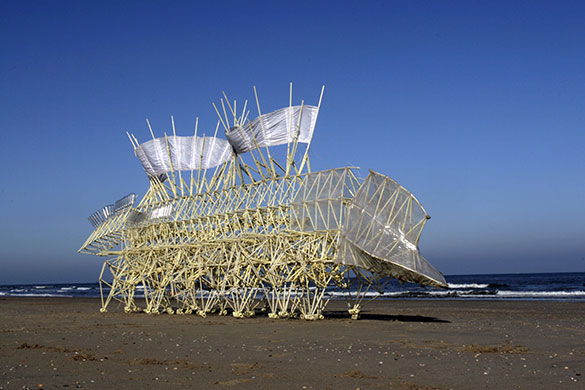Well, the world didn’t end, so the catastrophe continues. As Suzanne Ross has remarked, “We need no divine intervention to destroy the world–we are perfectly capable of doing it ourselves, thank you very much.” Even so, the major fail of the latest Last Days prediction opens, for only a moment, a curious window for seeing things anew. The snide but understandable pleasure in seeing another media evangelist make a fool of himself extends only so far, and beyond that the invocation of new heavens and a new earth (Isaiah 65:17) remains a distant yet radical promise. That promise can be understood not as an assurance of divine intervention, but rather as the insistence that human societies can provide prosperity instead of exploitation and peace rather than war. In short, that the the order of things can be turned upside down.
Like this, perhaps. Were the two machines reversed, the 52-ton tank would crush the spindly treadmill. But, for once, in a rare moment of imagination, leisure trumps warfare. The art work by Jennifer Allora and Guillermo Calzadilla is part of an exhibition scheduled for this summer’s Venice Biennale. The work is delightfully not didactic, and yet it invites reflection on pragmatic questions. The machines seem to be going in opposite directions, yet neither is going anywhere. They seem to be opposites in many ways: e.g., the human runner would be outside the treadmill, while the crew would be inside the tank. Yet they also are complements: both are machines, and fitness is needed for warfare, and the middle class workout may be complicit with the national security state. Most important, the artwork not only raises questions but also performs the process of inversion. And when the imagination is freed to think about what could be and ought to be possible, the answer is not going to be more of the same.
I could stop there, but one public artwork can evoke another, however accidental the connection might be. This is one of the “Strandbeests” made by the Dutch artist Theo Jansen. The work invites many associations, but I see a large, endangered species lumbering along a shoreline. Perhaps it is the animal’s last shore, the liminal, nearly empty space where it will at last lay down and die. Like an old tank, you might say, when the last of the oversize military hardware is being abandoned to its fate as ruins of an era no longer even remembered. Or perhaps it is something beyond that: one of the delightful creature-crafts that could emerge once the war machines no longer ruled the land.
In reality, of course, the artworks are far less permanent than the military-industrial complex. War will continue, as will economic exploitation and untold suffering perpetrated by those who know only too well that God is not going to intervene. Photojournalists will continue to bring us the bad news, and risk their lives to do it. Photography also can relay other public arts, however, and with that the opportunity to turn from cynicism, however pleasurable it can be, to whimsy, imagination, and the brief possibility of genuine transformation.
First photograph by Daniele Resini and Vincent G. Allora. Second photograph by the Spacex gallery.


Discussion